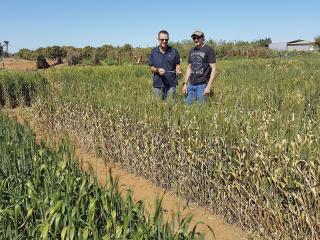Research to quantify yield losses from a range of cereal diseases is underway, which will assist growers to select the best varieties and disease management strategies suited to their cropping programs.
The Department of Primary Industries and Regional Development (DPIRD) is leading a national collaboration to develop yield loss response curves for several significant wheat and barley diseases, with co-investment from the Grains Research and Development Corporation (GRDC).
Department senior plant pathologist Manisha Shankar said the yield loss data would build on disease resistance and tolerance ratings for cereals provided in the annual variety guide.
"This research will provide growers with crucial information about the likely yield losses associated with disease rating categories for various wheat and barley varieties grown in Australia," Dr Shankar said.
Carefully targeted field trials are currently underway in Western Australia, South Australia, New South Wales, Queensland and Victoria, with disease assessments undertaken at various times of the season.
For the past three years, experiments have examined the impact of six wheat foliar diseases, including yellow spot, stagonospora nodorum blotch, septoria tritici blotch, as well as leaf, stem and stripe rusts.
These diseases are estimated to cost the Australian wheat industry $468 million annually in lost yield and control costs.
"This is a very comprehensive project, which involves around 36 experiments in locations across five States, including twelve in Western Australia," Dr Shankar said.
"The research team is developing new analysis methods to assist in the interpretation of the data and presenting it in a user friendly way so growers are able to make more informed decisions to optimise their crop potential."
The project participants alongside DPIRD include Agriculture Victoria, New South Wales Department of Primary Industries and Queensland Department of Agriculture and Fisheries.
Initial results have shown that varieties with different levels of resistance may express different rates of yield loss, different extents of yield loss or both, depending on the type of disease.
The project expects the yield loss information to be extended to industry in 2018 and integrated into wheat and barley variety guides in 2019.
Cereal growers in southern areas have been advised to monitor crops for signs of leaf, stem and stripe rust, as the weather warms up.
Dr Shankar said with autumn rains then a delayed start to the 2017 growing season, she expected reports of rust to increase in coming weeks, after recent isolated observations on the south coast.
"It is important for growers to correctly diagnose the type of rust and to treat affected crops promptly, paying particular attention to chemical registration requirements," she said.
"It is far more effective to take action while the disease is at low levels, than to leave it until the disease has become established."

Media contacts: Jodie Thomson/Megan Broad, media liaison +61 (0)8 9368 3937
